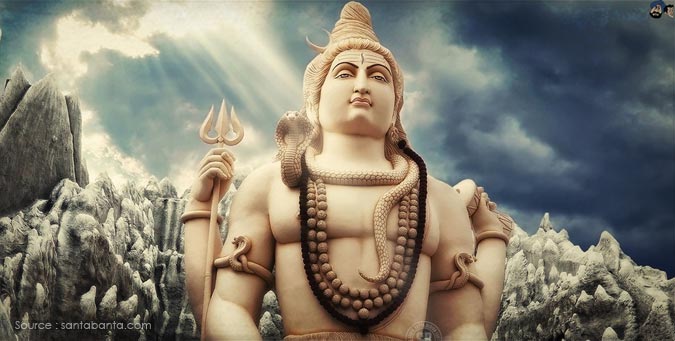''Brand SRK'' has become Bigger than even Shah Rukh Khan himself. From being among actors who pay the hi..

Indian thought and practices over time immemorial have commemorated certain days and festivals as ways and means for people to understand, remember and reunite with the Universe and the divinities of the Universe. Among the Indian pantheon of divinities, few are historical (like Rama and Krishna) and many others are Tattva, principles, essence in nature like the Shiva Tattva.
Shivaratri is one such festival which is a gateway to reach out and understand the divinity called Shiva or Shiva Tattva.
Shiva-Shava : From a metaphysical perspective, Shiva can be split as sha+ee+va where
'sha' stands for Shareeram, body,
'ee' stands for eeshwari, life giving energy (Shakt"ee") and
'va' stands for vayu or motion.
If the Shakt“ee” is removed from Shiva (potential of life), it gets reduced to sha+va or shava (lifeless body)
Making this potential manifest as matter, life and the cosmos, is Shaktee the energy tattva, the female counterpart of Shiva. Without Shaktee, Shiva stays as the potential. It is Shakti that triggers Shiva into manifesting as life.
Meaning of the term Shiva : The term “Shiva” has a much larger connotation which includes-
- having the potential,
- being capable of,
- boding well,
- being favourable, promising.
Thus this Shiva, auspiciousness is the very life of the universe. Not just the life we see around us in a very limited perspective of life in humans, animals or plants but the very concept of life itself.
Understanding Night, Ratri : The word Ratri means “comfort giver”. It is derived from the root word “ram” meaning “to be content”, “to give contentment”. It is during the ratri or night of any being, that the being gets rejuvenated and refreshed for its next cycle or day.
What is a Pralaya? : Laya means to merge or dissolve into. Music that makes one forget everything and makes one blend with the music is said to have Layam. It is also a rhythm. The prefix Pra denotes special as in Prakrithi which is primordial or ultimate Nature. Pralaya thus simply means the rhythmic, special dissolution or merging back into ultimate natural form.
Appreciating Shivaratri : The interim state between a dissolution and a regeneration is a period of both serenity and tranquility when all bodies are calm and preparing for regeneration. Following this tranquility is the joy and celebration which comes with having been regenerated and refreshed.
Shiva, being the potential to manifest, is the divinity for dissolution and regeneration. Hence the time one readies for rejuvenation and regeneration that comes with a Pralaya, is associated with Shiva as Shivaratri.
When there is resistance to a change, there is pain. Where there is willful acceptance, there is no pain. When we understand and willingly accept that a dissolution is only for a regeneration, the dissolution or change ceases to cause pain.
Shivaratri is an occasion that makes us aware of the need to change along with the ever changing cosmos and to renew our cosmic connect. It is a window to prepare ourselves to accept the change, to let go of the past, to make way for the new and the rejuvenation that comes forth. It is a celebration to welcome the change, the rejuvenation.
Therefore for time immemorial our ancestors have given this night of regeneration, a feeling of serenity through fasting and praying and have followed it with celebration through music, singing and dance.
Rishi Kahola Kaushitaki in his Kaushitaki Brahmana records that Maha Shivaratri was celebrated even during the Mahabharatha times, i.e. 5100 years ago.
Every Shivaratri, let us connect with this Shiva Tattva and get rejuvenated to face the coming phases of our lives.
(A more detailed article is available on bharathgyanblog.wordpress.com)
Bharath Gyan | www.bharathgyan.com | twitter.com/bharathgyan | facebook.com/bharathgyan
Share Your View via Facebook
top trend
-

Khan in 'Sheh' of Congress?
-

Baloch leaders hail US Resolution on Balochistan
Rampant violation of human rights and continuous exploitation of the natural wealth of Balochistan by Pakistan has been ..
-

Rules Do Not Make Ram
If there were no rules, would we be corrupt? Do rules make us corrupt? After all, only when there are rules can rules be b..
-

Dynasty responsible for Congress rout, its beginning, we shall soon see the end!
"The voters rejected the Congress in UP,” said a Congress leader a day after the party got a pounding in the ..
-

Ramdev to disclose names of two leaders having account in Swiss Bank on Jan 14
Yoga guru Baba Ramdev today threatened to reveal the names of two top leaders on Jan 14, Makar Sankranti, who he alleged h..
what next
-
-
"Coal allocations since 1993 are arbitrary and illegal", Says Supreme Court
-
Palestine, 6 billion people and second hand opinions
-
Malegaon 2006 vs. Malegaon 2008 - Blast Politics
-
Who will investigate Chidambaram & Co for the Dabhol Loot?
-
Narendra Modi prepares to climb the ramparts of the Red Fort
-
The Great Jindal Swindle
-
AAP's insidious anti-Hindu agenda
-
Nagma - Sonia Gandhi's Star Soldier
-
Aam Aadmi Party : Anti-Modi stalking horse
-
What in God's name is Teesta Setalvad's agenda?
-
-
-
Time to rethink : Saffron surge and the secular debacle - Sri Sri Ravi Shankar
-
India's Wishlist for Prime Minister Narendra Modi
-
My first meeting with Narendra Modi - Sri Sri Ravi Shankar
-
Telangana - Divide and Rule?
-
Myths vs Facts about RSS
-
The Two States: Telangana and Seemandhra
-
Answering Media on Questions to Narendra Modi, but will they venture into responding these queries?
-
#AAPCon : Dilli ke log ban gaye Mamu
-
Secularism is just synonymous with Sanatan Dharm
-
Beware of the Hoax called Aam Aadmi Party
-










Comments (Leave a Reply)